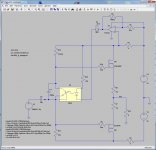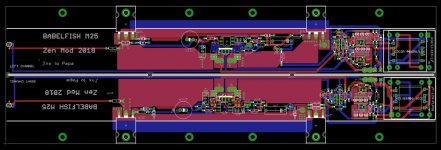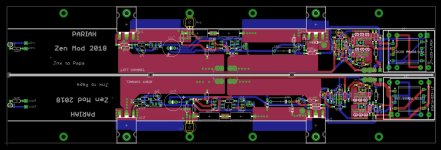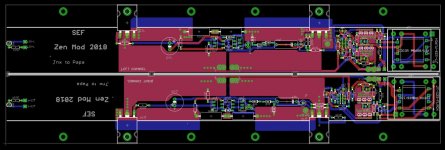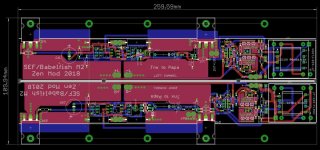The Wizard is having fun from conception of idea, design of topology, choosing parts, testing through building it. He knows what he wants and doesn't want while having a 40+ years of hands on know how behind him. When we see performance improvement on an adaptation of his design, it is simply a performance closer to what we want but could be irrelevant to his concept and design objectives......... "who cares , I made it good enough "
having fun , while making it is , I believe , most important thing .......
Some of us are happy simply to be able to diy a great amp, but some other sort of seek more involving experience, know what they want and don't want while having very limited know how but dare to press on dreaming thanks to Papa and other masters providing their shoulders for us to lean on. Difficult for me to put into words, but I think you understand.🙂
Yup. I realized, after building and listening Pass amps, and reading his arties, that I want/like distortion. But, certain mix of distortion. I think that there must be a shift of attitude in hi-fi world, among audiophiles, and that the attitude od "amplifier with zero disttortion" is simply wrong. It is like making a clean and sterile food, but which is totally tasteless. On the other had, if we admit and recognize the fact that all amps create distortion, but this distortion shouldn't be ignored or minimized. It should be "shaped" in order to give a certain flavor to the music. It bears some similarity to speakers vs.rooms. Nobody listnens in the anechoic room. Instead of "ignoring the room" one must design/build speakers that "work with the room", something that Mr. Linwitz did. Now,instead of ignoring the distortion and trying to bring it to zero, one must recognize that it should be "left to distort" but shape it in a pleasant way. I believe that Nelson Pass has taken the right approach, and this amp (among other nice ones) just proves the point...
Great, another fellow on the quest. Finding the suitable "certain mix" that works good enough to our taste on our system is certainly a very "interesting" journey.😀
Re current sensing: if you are concerned about Iq through an SOIC chip can I suggest some low tech approach?
OpAmp that an handle positive rail input to sense the current from your CRC.
Please excuse the dirty trick with the red LED, but TL071 output doesn't go to the rail. I am sure there is better opamps for this task.
OpAmp that an handle positive rail input to sense the current from your CRC.
Please excuse the dirty trick with the red LED, but TL071 output doesn't go to the rail. I am sure there is better opamps for this task.
Attachments
covered myriad of solutions
OP was in early ones , later switched to 0R1 in rails , optocouplers and additional precision CCS
later switched to CMirrors , luckily tipped to that (as usually ) here on forum
I believe this (Hall) approach is most likely last iteration .....
OP was in early ones , later switched to 0R1 in rails , optocouplers and additional precision CCS
later switched to CMirrors , luckily tipped to that (as usually ) here on forum
I believe this (Hall) approach is most likely last iteration .....
Last edited:
It just cross my mind that the Hall chip can easily be made to serve double duty to overcurrent protection scheme you may want to incorporate for that particular babelfish project.I made my own layout solution , ...
yup , thought of that ........ already existing pair of rail chips , then separate summing net to , say , triac for shutting gates together .......
exact values of summing resistor net needs to be tuned in vivo , due to lalala behavior of triacs
anyway , not overly puzzled with that , I'm not going to sell that amp to unknown fool ,invoking protection tripping (as Papa does) ........ I know that this fool is little more careful , so mains fuse will do just nicely

exact values of summing resistor net needs to be tuned in vivo , due to lalala behavior of triacs
anyway , not overly puzzled with that , I'm not going to sell that amp to unknown fool ,invoking protection tripping (as Papa does) ........ I know that this fool is little more careful , so mains fuse will do just nicely

ZM ... why did you decide not to use the 0.1r in rails way ? My Guess was that papa use that rail resistor method in xa25 ... not that we have to necessarily copy his approach but juts curious ...
I know which value Papa is using (can't tell 🙂 )
I decided to use 0R1 as biggest I can cope mentally with (when you know a smudge , it's normal to fixate on irrelevant things , like value of power resistor in rail , Shinkoh , Obligato , Dale nonmagnetic etc. ) and practically smallest - to avoid constructing MC prepre as gain stage for servo circuit ........ which in this case bias mech. really is - servo)
however , I'm going to pursue those Hall chips found by indra not as something better than I already have , but as something worth pursuing
hehe , not (as used to be said) - pursue because of pursue itself but because of simple joy in pursuit
same drek , different explanation
I decided to use 0R1 as biggest I can cope mentally with (when you know a smudge , it's normal to fixate on irrelevant things , like value of power resistor in rail , Shinkoh , Obligato , Dale nonmagnetic etc. ) and practically smallest - to avoid constructing MC prepre as gain stage for servo circuit ........ which in this case bias mech. really is - servo)
however , I'm going to pursue those Hall chips found by indra not as something better than I already have , but as something worth pursuing
hehe , not (as used to be said) - pursue because of pursue itself but because of simple joy in pursuit
same drek , different explanation

For that scheme, easier to use a High-Side Current Sense Amplifier like the Si8540, but not as versatile as Hall chip.... I am sure there is better ...
- Home
- Amplifiers
- Pass Labs
- Most Greedy Boy, of them all... or (there is no) DEFiSIT of Papa's Koans
